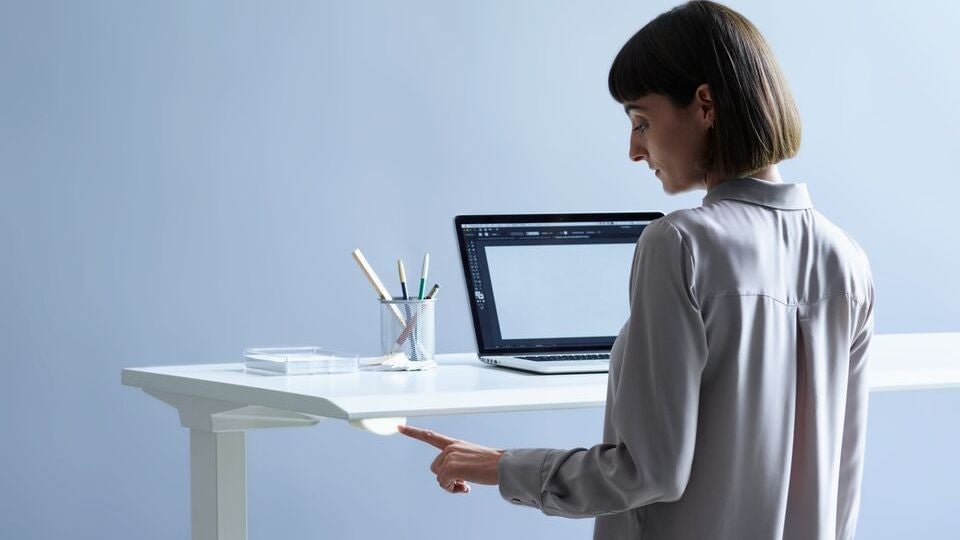Herman Miller, creator of the Aeron chair, wants to make your desk more like a Fitbit
Herman Miller, the creator of the cubicle and the iconic Aeron chair, will begin selling sensors this week that connect its desks to the cloud—the first phase of a plan to add a layer of technology to your office workstation.


Herman Miller, the creator of the cubicle and the iconic Aeron chair, will begin selling sensors this week that connect its desks to the cloud—the first phase of a plan to add a layer of technology to your office workstation.
The sensors, which can be installed on any work surface, collect anonymized data about which spaces are used most; the facility’s manager can access the data through a dashboard in order to inform design and other types of decisions. Another version of the product, which can be added only to Herman Miller stand-to-sit desks, also keeps tabs on how often employees, in aggregate, change positions between standing and sitting. With this later version, workers can elect to use an app in which they set goals for changing between sitting and standing positions throughout the day. When it’s time for them to stand up or sit down, according to their goal, the desk’s controller will subtly vibrate, like the alarm function on a wearable fitness tracker. Herman Miller calls the whole system “Live OS.”
It’s not cheap. Each sensor alone costs around $100, and the software to go with them costs $36 per desk per year, including cellular connectivity costs (the system runs independently from client IT networks for security reasons). The option that works with Herman Miller sit-to-stand desks and comes with an app for workers costs $60 per desk per year (both prices go down with volume and as clients subscribe for longer periods of time).
Desks may seem like the epitome of stationary, analog objects that do not need to be “smart.” But there are ways in which installing sensors in furniture actually makes some, er, sense.
Companies have financial reasons to understand better how workers are using office space. “The design of office space for 20 to 30 years became pretty predictable because people used desktop computers and desktop phones,” says Ryan Anderson, a business development executive at Herman Miller. “In the last several years, mobile technology has changed the game. People can work anywhere within the space or outside the space. It used to be if you had 300 people, you bought 300 desks and chairs, and assigned everyone a space. That’s not the reality of how most people work today. Most people will have more varied activities and will do their work from more than one place.” Designing those places efficiently can save money.

Sensors are already hidden all over offices, including in the lights and in name badges. Humanyze, a company that analyzes office interactions by combing through digital communication, and offers an option that involves badges for collecting aggregate data about in-person interactions, examines not only how people interact and what their workloads look like, but also how they use space. Light bulbs with movement analytics, like those made by Enlighted and GE’s Current, track workers’ movements through office space. Companies say these sorts of anonymized data help answer questions related to decreasing occupancy costs, managing conference room space, utilizing real estate better and even extending the life of office furniture.
Standing desks can also be more complicated than you might think. While there’s still a debate over exactly whether and how standing desks benefit workers and employers, there’s near consensus that both sitting all day and standing all day are not good for you. “Standing for prolonged periods of time has its own problems, including increased joint pain, swelling, restricted blood flow, stiffness, and fatigue,” Lucas J. Carr, assistant professor in the Department of Health & Human Physiology at the University of Iowa, told Fast Company. Furniture designers like Herman Miller have responded with desks that can be moved from sitting to standing. These can be quite expensive investments—Herman Miller’s version costs companies between $500 and $1,500—and employees don’t always use them. Technology could theoretically help workers get in the habit.
The ups and downs of working at standing desks gets even more complicated to manage with “hot desking,” a trendy office arrangement in which workers don’t have designated workspaces but rather move between shared desks at their own discretion. Herman Miller solved this problem with its app, where users can designate preferred settings that travel with them from desk to desk via a Bluetooth signal from their phones.
If you still think that’s an excessive amount of technology to put into a desk, just wait until you meet the connected chair.
In January, Herman Miller plans to extend its Live OS offering with a smart Aeron chair, which will have sensors built into its fabric-like material that can infer workers’ posture problems and allow Herman Miller’s software to recommend adjustments. That chair will share information with sensor-enabled desks so that when workers stand, the desk will raise to a standing height automatically—without the need to even touch a controller.